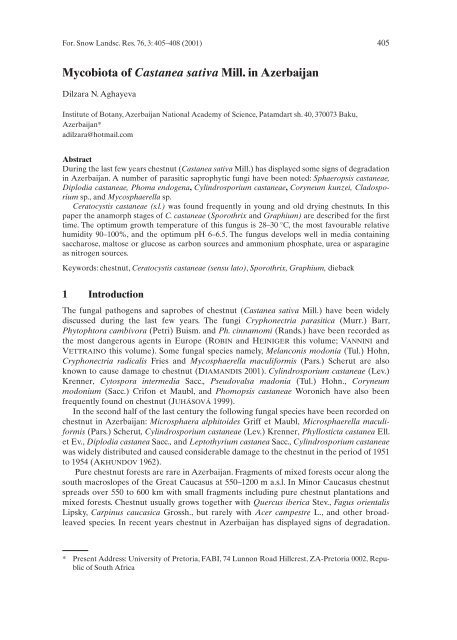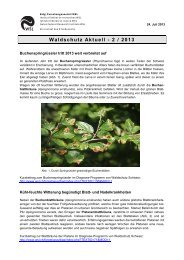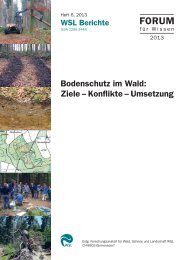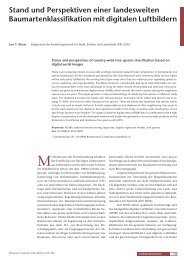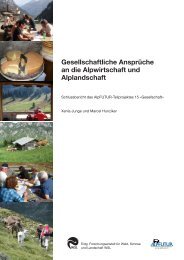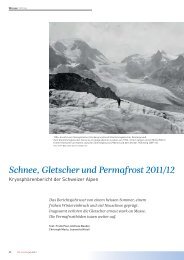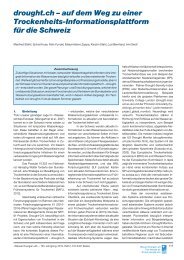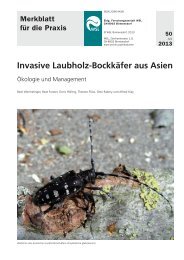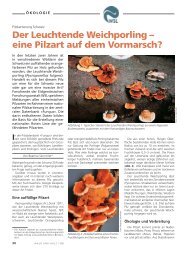Mycobiota of Castanea sativa Mill. in Azerbaijan - WSL
Mycobiota of Castanea sativa Mill. in Azerbaijan - WSL
Mycobiota of Castanea sativa Mill. in Azerbaijan - WSL
Create successful ePaper yourself
Turn your PDF publications into a flip-book with our unique Google optimized e-Paper software.
For. Snow Landsc. Res. 76, 3: 405–408 (2001)<br />
<strong>Mycobiota</strong> <strong>of</strong> <strong>Castanea</strong> <strong>sativa</strong> <strong>Mill</strong>. <strong>in</strong> <strong>Azerbaijan</strong><br />
Dilzara N. Aghayeva<br />
Institute <strong>of</strong> Botany, <strong>Azerbaijan</strong> National Academy <strong>of</strong> Science, Patamdart sh. 40, 370073 Baku,<br />
<strong>Azerbaijan</strong>*<br />
adilzara@hotmail.com<br />
Abstract<br />
Dur<strong>in</strong>g the last few years chestnut (<strong>Castanea</strong> <strong>sativa</strong> <strong>Mill</strong>.) has displayed some signs <strong>of</strong> degradation<br />
<strong>in</strong> <strong>Azerbaijan</strong>. A number <strong>of</strong> parasitic saprophytic fungi have been noted: Sphaeropsis castaneae,<br />
Diplodia castaneae, Phoma endogena, Cyl<strong>in</strong>drosporium castaneae, Coryneum kunzei, Cladospo -<br />
rium sp., and Mycosphaerella sp.<br />
Ceratocystis castaneae (s.l.) was found frequently <strong>in</strong> young and old dry<strong>in</strong>g chestnuts. In this<br />
paper the anamorph stages <strong>of</strong> C. castaneae (Sporothrix and Graphium) are described for the first<br />
time. The optimum growth temperature <strong>of</strong> this fungus is 28–30 °C, the most favourable relative<br />
humidity 90–100%, and the optimum pH 6–6.5. The fungus develops well <strong>in</strong> media conta<strong>in</strong><strong>in</strong>g<br />
saccharose, maltose or glucose as carbon sources and ammonium phosphate, urea or asparag<strong>in</strong>e<br />
as nitrogen sources.<br />
Keywords: chestnut, Ceratocystis castaneae (sensu lato), Sporothrix, Graphium, dieback<br />
1 Introduction<br />
The fungal pathogens and saprobes <strong>of</strong> chestnut (<strong>Castanea</strong> <strong>sativa</strong> <strong>Mill</strong>.) have been widely<br />
discussed dur<strong>in</strong>g the last few years. The fungi Cryphonectria parasitica (Murr.) Barr,<br />
Phytophtora cambivora (Petri) Buism. and Ph. c<strong>in</strong>namomi (Rands.) have been recorded as<br />
the most dangerous agents <strong>in</strong> Europe (ROBIN and HEINIGER this volume; VANNINI and<br />
VETTRAINO this volume). Some fungal species namely, Melanconis modonia (Tul.) Hohn,<br />
Cryphonectria radicalis Fries and Mycosphaerella maculiformis (Pars.) Scherut are also<br />
known to cause damage to chestnut (DIAMANDIS 2001). Cyl<strong>in</strong>drosporium castaneae (Lev.)<br />
Krenner, Cytospora <strong>in</strong>termedia Sacc., Pseudovalsa madonia (Tul.) Hohn., Coryneum<br />
modonium (Sacc.) Crifon et Maubl, and Phomopsis castaneae Woronich have also been<br />
frequently found on chestnut (JUHÁSOVÁ 1999).<br />
In the second half <strong>of</strong> the last century the follow<strong>in</strong>g fungal species have been recorded on<br />
chestnut <strong>in</strong> <strong>Azerbaijan</strong>: Microsphaera alphitoides Griff et Maubl, Microsphaerella maculi -<br />
formis (Pars.) Scherut, Cyl<strong>in</strong>drosporium castaneae (Lev.) Krenner, Phyllosticta castanea Ell.<br />
et Ev., Diplodia castanea Sacc., and Leptothyrium castanea Sacc., Cyl<strong>in</strong>drosporium castaneae<br />
was widely distributed and caused considerable damage to the chestnut <strong>in</strong> the period <strong>of</strong> 1951<br />
to 1954 (AKHUNDOV 1962).<br />
Pure chestnut forests are rare <strong>in</strong> <strong>Azerbaijan</strong>. Fragments <strong>of</strong> mixed forests occur along the<br />
south macroslopes <strong>of</strong> the Great Caucasus at 550–1200 m a.s.l. In M<strong>in</strong>or Caucasus chestnut<br />
spreads over 550 to 600 km with small fragments <strong>in</strong>clud<strong>in</strong>g pure chestnut plantations and<br />
mixed forests. Chestnut usually grows together with Quercus iberica Stev., Fagus orientalis<br />
Lipsky, Carp<strong>in</strong>us caucasica Grossh., but rarely with Acer campestre L., and other broad -<br />
leaved species. In recent years chestnut <strong>in</strong> <strong>Azerbaijan</strong> has displayed signs <strong>of</strong> degra dation.<br />
* Present Address: University <strong>of</strong> Pretoria, FABI, 74 Lunnon Road Hillcrest, ZA-Pretoria 0002, Republic<br />
<strong>of</strong> South Africa<br />
405
406 Dilzara N. Aghayeva<br />
A dry<strong>in</strong>g process has been observed <strong>in</strong> chestnuts <strong>in</strong> forests, plantations and private plots <strong>in</strong><br />
the Great Caucasus. The <strong>in</strong>tensity <strong>of</strong> dieback is 45 to 50%. The purpose <strong>of</strong> this study was to<br />
<strong>in</strong>vestigate the mycobiota <strong>in</strong>volved <strong>in</strong> chestnut dieback.<br />
2 Materials and methods<br />
The fungi were isolated from dry<strong>in</strong>g chestnut trees <strong>in</strong> mixed forests or chestnut plantations that<br />
were 30 years old or older. Leaves, dead and liv<strong>in</strong>g branches and xylem from trees attacked by<br />
bark beetles were observed under the microscope (MBR-3). Specimens <strong>in</strong> which it was suspected<br />
that species <strong>of</strong> Ceratocystis were grow<strong>in</strong>g, but not yet sporulat<strong>in</strong>g, were placed <strong>in</strong> a damp chamber.<br />
Fungal isolations were made by transferr<strong>in</strong>g spore masses to MEA (20g malt extract, 20g agar per<br />
L water). Identification was made accord<strong>in</strong>g to POTLAYCHUK and SHEKUNOVA (1985). Mor -<br />
phological traits <strong>in</strong> culture, optimum pH and temperature optimum were determ<strong>in</strong>ed accord<strong>in</strong>g to<br />
BILAY and ELLANSKAYA (1982). The growth <strong>of</strong> the fungus was studied <strong>in</strong> liquid glucose-m<strong>in</strong>eral<br />
medium with the pH rang<strong>in</strong>g from 4.5 to 7.0 at 28 °C. The growth was measured by weigh<strong>in</strong>g the<br />
dry biomass. Optimum growth temperature was def<strong>in</strong>ed on MEA by measur<strong>in</strong>g the diameter <strong>of</strong><br />
the colonized area (<strong>in</strong> mm). The effect <strong>of</strong> humidity on the germ<strong>in</strong>ation <strong>of</strong> spores was studied<br />
accord<strong>in</strong>g to KHOKHRYAKOV (1976) <strong>in</strong> the exsiccator with humidities <strong>of</strong> 50, 60, 70, 80, 90 and<br />
100%. Spores on the dry glass slide were placed <strong>in</strong> the exsiccator at the optimal temperature <strong>of</strong><br />
28 °C. All experiments were performed three times. The carbohydrate and nitrogen requirements<br />
<strong>of</strong> the fungus were studied on Czapek’s agar (20g sucrose, 2g NaNO 3, 1g KH 2PO 4, 0.5g MgSO 4<br />
7H 2O, 0.5g KCl , 0.01 g FeSO 4 per L water) with a m<strong>in</strong>or modification (BILAY 1978): Sucrose was<br />
replaced by 20g maltose, glucose, cellobiose or cellulose each. 0.4% <strong>of</strong> NaNO 3, NH 4NO 3,<br />
(NH 4) 3PO 4, urea or asparag<strong>in</strong> were used as nitrogen sources. Media without any carbohydrate<br />
and nitrogen sources served as controls. The grow<strong>in</strong>g temperature was 28 °C.<br />
3 Results<br />
The first symptoms <strong>of</strong> chestnut dry<strong>in</strong>g appeared <strong>in</strong> June. Leaves became red, gradually<br />
turned yellow, dried out and fell <strong>of</strong>f. Dry<strong>in</strong>g began from the top <strong>of</strong> trees. At first th<strong>in</strong>, one to<br />
two year old summer branches died back, then the thicker branches. The process <strong>of</strong> dry<strong>in</strong>g<br />
spread down along the crown gradually. Dark brown l<strong>in</strong>es and dark or brownish wood<br />
elements were noted under the bark <strong>of</strong> the dry<strong>in</strong>g trees. Chestnut dry<strong>in</strong>g is chronic <strong>in</strong> nature<br />
and complete dry<strong>in</strong>g out <strong>of</strong> trees can be observed with<strong>in</strong> 4 to 10 years. This dry<strong>in</strong>g has been<br />
noted s<strong>in</strong>ce 1981 <strong>in</strong> Great Caucasus. The follow<strong>in</strong>g fungal species were recorded on the<br />
affected chestnut wood, twigs and leaves: Ceratocystis castaneae (Van<strong>in</strong> et Solov.) C.<br />
Moreau, Sphaeropsis castaneae Togn., Diplodia castaneae Sacc., Phoma endogena Speg.,<br />
Cyl<strong>in</strong>drosporium castaneae (Lev.) Krenner., Coryneum kunzei Cda., Cladosporium sp., and<br />
Mycosphaerella sp. Cryphonectria parasitca was noted only once <strong>in</strong> 1942 <strong>in</strong> <strong>Azerbaijan</strong>. S<strong>in</strong>ce<br />
then it has no longer been found (unpublished data).<br />
Ceratocystis castaneae was found under the bark <strong>of</strong> dry<strong>in</strong>g chestnuts <strong>in</strong> the Gabala forest<br />
for the first time <strong>in</strong> 1981 and aga<strong>in</strong> <strong>in</strong> 1994 (GUSEYNOV and AGHAYEVA 1997). S<strong>in</strong>ce 1994 it<br />
has been observed <strong>in</strong> other forests too (ma<strong>in</strong>ly <strong>in</strong> Great Caucasus). Perithecia develope<br />
abundantly on xylem. In culture, colonies are fast grow<strong>in</strong>g, cover<strong>in</strong>g a petri dish <strong>in</strong> 15 days at<br />
25 to 30 °C. In the beg<strong>in</strong>n<strong>in</strong>g the colonies are white, later becom<strong>in</strong>g white to grey. Both<br />
Sporothrix (Hektoen et Perk<strong>in</strong>s) and Graphium (Cda.) types anamorphs have been recorded.<br />
The conidiophores <strong>of</strong> Sporothrix anamorphs are clearly branched, hyal<strong>in</strong>e, septate, 33.6–47.6<br />
(42.9) x 2.5–2.8 (2.4) µm. The conidiogenous cells arise term<strong>in</strong>ally on conidiophores as<br />
sympodial denticles. Conidia are holoblastic, hyal<strong>in</strong>e, th<strong>in</strong>-walled, unicellular, oblong to<br />
ellipsoidal, clavate, 2.8–5.6 x 1.1–1.5 µm. They are formed s<strong>in</strong>gly, later becom<strong>in</strong>g aggregated<br />
<strong>in</strong> a slimy mass. The coremia <strong>of</strong> the Graphium type are brown, black, pale brown or subhya-
For. Snow Landsc. Res. 76, 3 (2001)<br />
l<strong>in</strong>e toward the apex, 240–504 µm long <strong>in</strong>clud<strong>in</strong>g the head, 36–84 µm <strong>in</strong> diameter at the base,<br />
and 36–72 µm near the head. The diameter <strong>of</strong> the head is 120–210 µm. Conidia are onecelled,<br />
hyal<strong>in</strong>e, oblong-cyl<strong>in</strong>drical, sometimes curved, 4.2–8.4 (9.8) x 2.1–2.8 µm accumulat<strong>in</strong>g<br />
<strong>in</strong> slimy heads. In culture coremia formed abundantly <strong>in</strong> concentric circles. Ascocarps were<br />
produced on the 35 th to 38 th day on MEA after keep<strong>in</strong>g the culture at a low positive<br />
tempera ture (8–12 °C) for the first 10 days. They are numerous, arranged <strong>in</strong> concentric<br />
circles, <strong>in</strong>nate to superficial, dark brown, 132–180 µm <strong>in</strong> diameter, and covered by septate,<br />
dark brown hairs, which are 48–75 µm <strong>in</strong> length and 3–5 µm thick at the base. Necks <strong>of</strong> the<br />
ascocarps are 1200–1700 µm long, 24–36 µm at the base and 12–14.4 µm thick at the top, with<br />
pale cilia, 24–48 µm long. Asci are evanescent. Ascospores are hyal<strong>in</strong>e, unicellular, commalike,<br />
4.5 x 6.5 µm. They aggregate <strong>in</strong> a slimy mass at the top <strong>of</strong> the neck and flow down on it.<br />
This description does not fit the literature completely, and there are several differences to<br />
the description by POTLAYCHUK and SHEKUNOVA (1985) (Table 1).<br />
The development <strong>of</strong> C. castaneae has been studied under laboratory conditions. Optimum<br />
growth temperature was 28–30 °C. The growth <strong>of</strong> fungus ceased at temperatures below <strong>of</strong><br />
5 °C and above 40 °C. The most favourable humidity for spore germ<strong>in</strong>ation was 90–100%.<br />
High humidity and high temperatures were not lethal to the fungus, but low humidity at high<br />
temperatures was lethal. Optimum growth was at pH 6–6.5. Tests on the use <strong>of</strong> carbohydrate<br />
and nitrogen sources showed that the fungus assimilated common sugars easily and de -<br />
veloped well <strong>in</strong> the media conta<strong>in</strong><strong>in</strong>g sucrose, maltose or glucose. The growth <strong>of</strong> cultures on<br />
cellulose and cellobiose was near the control without a carbohydrate source. The results also<br />
showed that the fungus assimilated (NH 4) 3PO 4 and organic nitrogen better than NaNO 3.<br />
Table 1. Comparative data for Ceratocystis castaneae (<strong>in</strong> µm).<br />
Ascocarp Hairs at the base Necks Ostiolar hyphae Ascospores<br />
<strong>in</strong> POTLAYCHUK<br />
and SHEKUNOVA 84–42 x 68–85 204–347 1000–1800 14.7–20 4.4–7.4<br />
our observations 132–180 48–75 1200–1700 24–48 4.4–6.5<br />
4 Discussion<br />
All the recorded species (Sphaeropsis castaneae Togn., Diplodia castaneae Sacc., Phoma<br />
endogena Speg., Cyl<strong>in</strong>drosporium castaneae (Lev.) Krenner., Coryneum kunzei Cda.,<br />
Cladosporium sp., Mycosphaerella sp.) except C. castaneae (Van<strong>in</strong> et Solov.) C. Moreau are<br />
considered to be rare on chestnut. This last species is <strong>of</strong>ten found on dry<strong>in</strong>g chestnut.<br />
SOLOVYOV (1932) first described the fungus C. castaneae under the name Ceratostomella<br />
castaneae (Van<strong>in</strong> et Solov.), as a saprotroph caus<strong>in</strong>g a blue sta<strong>in</strong> <strong>in</strong> the wood <strong>of</strong> <strong>Castanea</strong> sp.<br />
Later the fungus was assigned to the genus Ophiostoma and noted as Ophiostoma castaneae<br />
(Van<strong>in</strong> et Solov.) Nannf. (cited <strong>in</strong> POTLAYCHUK and SHEKUNOVA 1985). It has also been<br />
<strong>in</strong>cluded <strong>in</strong> the genus Ceratocystis (MOREAU 1952). HUNT (1956) noted that the species may<br />
be imperfectly known because he was unable to obta<strong>in</strong> material. Then the species was<br />
classified as C. castaneae by POTLAYCHUK and SHEKUNOVA (1985). They classified the genus<br />
Ceratocystis and divided the species <strong>of</strong> the genus <strong>in</strong>to three groups, with C. castaneae<br />
ascribed to the 3rd group. These authors believe that the species may have either completely<br />
lost its ability to form anamorph sporulation or no sporulation has been dis covered yet.<br />
Their description <strong>of</strong> the species is very brief. My description partly corresponds to the<br />
literature, but <strong>in</strong> addition describes anamorph stages (Sporothrix and Graphium) that have<br />
not previously been found. UPADHYAY (1981) does not mention the species. C. casta neae was<br />
considered synonymous with Ceratostomella castaneae (Van<strong>in</strong> et Solov.) by SEIFERT et al.<br />
(1993). The systematic state has still to be exam<strong>in</strong>ed <strong>in</strong> detail.<br />
407
408 Dilzara N. Aghayeva<br />
Accord<strong>in</strong>g to POTLAYCHUK (1957) the species <strong>of</strong> the genus Certocystis occurr<strong>in</strong>g <strong>in</strong> oak<br />
may orig<strong>in</strong>ate from elm. By <strong>in</strong>fect<strong>in</strong>g maple it can be passed back to oak and elm aga<strong>in</strong>. In<br />
<strong>Azerbaijan</strong> the agent <strong>of</strong> oak decl<strong>in</strong>e was established as C. roboris and GUSEINOV (1984)<br />
experimentally proved its pathogenicity. Internal and external signs <strong>of</strong> dry<strong>in</strong>g chestnut trees<br />
correspond to similar symptoms <strong>of</strong> oak decl<strong>in</strong>e. It rema<strong>in</strong>s an open question whether the<br />
C. roboris has passed from oak to chestnut and then adapted to it.<br />
It is supposed that C. castaneae takes part <strong>in</strong> dry<strong>in</strong>g <strong>of</strong> chestnut trees but <strong>in</strong>oculation tests<br />
should be done to prove the pathogenicity <strong>of</strong> the fungus.<br />
Acknowledgements<br />
I am grateful to Dr. Ursula He<strong>in</strong>iger <strong>of</strong> the Swiss Federal Institute for Forest, Snow and Land -<br />
scape Research <strong>WSL</strong> for helpful comments on revis<strong>in</strong>g this article.<br />
5 References<br />
AKHUNDOV, T.M., 1962: The biology <strong>of</strong> the fungus caus<strong>in</strong>g sil<strong>in</strong>drosporioz <strong>of</strong> chestnut. News <strong>of</strong><br />
the <strong>Azerbaijan</strong> Academy <strong>of</strong> Science, ser. biol. sci. 2: 17–23. (In Russian)<br />
BILAY, V.I., 1978: Culture media. In: The methods <strong>of</strong> experimental mycologi. “Naukova Dumka”<br />
Kiev, p. 32. (In Russian)<br />
BILAY, V.I.; ELLANSKAYA I.A., 1982: Fundamental mycological methods <strong>in</strong> phytopathology. In:<br />
Methods <strong>of</strong> experimental mycology. Kiev. Naukova Dumka. 109: 423–431. (In Russian).<br />
GUSEYNOV, E.S., 1984: Vascular dieback <strong>of</strong> oak <strong>in</strong> <strong>Azerbaijan</strong> J. Micologiya and fitapatologiya L.,<br />
18, 2: 144–149. (In Russian)<br />
GUSEYNOV, E.S.; AGHAYEVA, D.N., 1997: The morphological and cultural signs <strong>of</strong> the vascular<br />
mycosis agents <strong>of</strong> forest tree types <strong>in</strong> <strong>Azerbaijan</strong>. Tr. J. <strong>of</strong> Botany 21: 19–26.<br />
DIAMANDIS, S., 2001: The myc<strong>of</strong>lora <strong>of</strong> the chestnut coppice ecosystems <strong>in</strong> Greece. COST G4<br />
Multidiscipl<strong>in</strong>ary Chestnut Research. Abstracts <strong>of</strong> F<strong>in</strong>al Meet<strong>in</strong>g. Switzerland. 47.<br />
KHOKHRYAKOV, M.K., 1976: Methods on experimental study <strong>of</strong> phytopathogens VIZR.<br />
Len<strong>in</strong>grad. 65 pp. (In Russian)<br />
JUHÁSOVÁ, G., 1999: Hubove choroby gastana jedleho (Castnea <strong>sativa</strong> <strong>Mill</strong>.) VEDA, Bratislava.<br />
191 pp.<br />
HUNT, J., 1956: Taxonomy <strong>of</strong> the genus Ceratocystis. Lloydia 19: 58 pp.<br />
MOREAU, C., 1952: Coexistence des formes Thielaviopsis et Graphium chez une souche de<br />
Ceratocystis major (van Beyma) nov. conb. Rev.Mycol. (Paris), Suppl. Col. 17: 17–25.<br />
POTLAYCHUK, V.I., 1957: Biology <strong>of</strong> the agent <strong>of</strong> oak decl<strong>in</strong>e. Proceed<strong>in</strong>gs <strong>of</strong> VIZR. Issue 8,<br />
Stavropol. 227–237. (In Russian)<br />
POTLAYCHUK, V.I.; SHEKUNOVA, Y.G. 1985: Distribution <strong>of</strong> the species <strong>of</strong> the genus Ceratocystis<br />
Ell. et Halst. emend Bakshi <strong>in</strong> USSR. Nov. Sys. Nizsh. Rast. L., Nauka 22: 148–156<br />
ROBIN, C.; HEINIGER, H., 2001: Chestnut blight <strong>in</strong> Europe: Diversity <strong>of</strong> Cryphonectria parasitica,<br />
hypovirulence and biocontrol. For. Snow Landsc. Res. 76, 3: 361–367.<br />
SEIFERT, K.A.; WINGFIELD, M.J.; KENDRICK, W.B., 1993: Species <strong>of</strong> uncerta<strong>in</strong> status. A nomenclature<br />
for described species <strong>of</strong> Ceratocystis, Ophiostoma, Ceratocystiopsis, Ceratostomella and<br />
Sphaeronaemella. In: Ceratocystis and Ophiostoma. Taxonomy, Ecology and Pathogenicity. St.<br />
Paul M<strong>in</strong>nesota, APS Press. 269–287.<br />
SOLOVYOV, F.A., 1932: Some rare and little-known species <strong>of</strong> fungi <strong>of</strong> North Caucasus region.<br />
Proceed<strong>in</strong>gs on Plant Protection. 5, 1, 1. (In Russian)<br />
UPADHYAY, H.P., 1981: A monograph <strong>of</strong> Ceratocystis and Ceratocystiopsis. Athens, University <strong>of</strong><br />
Georgia Press. 176 pp.<br />
VANNINI, A.; VETTRAINO, A.M., 2001: Ink disease <strong>in</strong> chestnuts: impact on the European chestnut.<br />
For. Snow Landsc. Res. 76, 3: 345–350.<br />
Accepted 4.3.02


